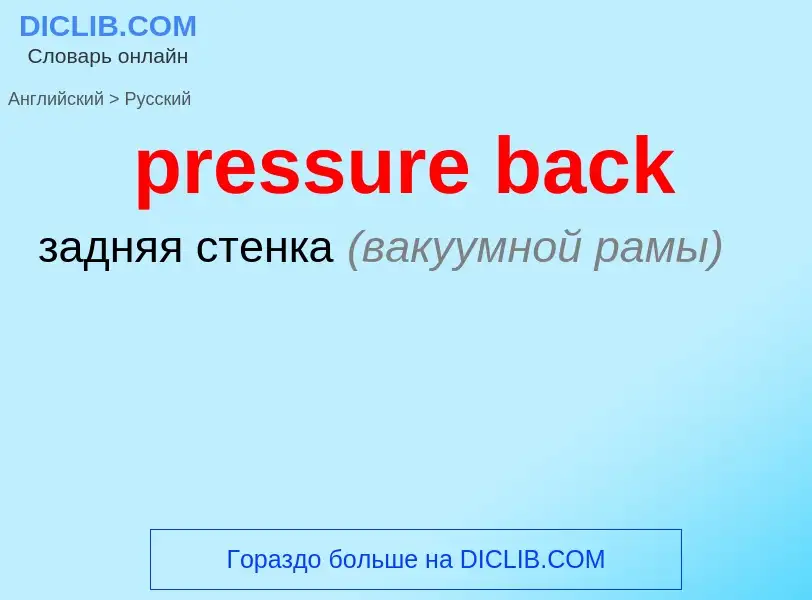Translation and analysis of words by artificial intelligence
On this page you can get a detailed analysis of a word or phrase, produced by the best artificial intelligence technology to date:
- how the word is used
- frequency of use
- it is used more often in oral or written speech
- word translation options
- usage examples (several phrases with translation)
- etymology
pressure back - translation to russian
[bæks]
общая лексика
парки и лужайки (кембриджских колледжей вдоль р. Кем; известны своей живописностью)
дословная передача
зады, так как колледжи обращены сюда своей задней стороной
существительное
общая лексика
парки и лужайки кембриджских колледжей вдоль реки Кем
Definition
Wikipedia

Pressure cooking is the process of cooking food under high pressure steam and water or a water-based cooking liquid, in a sealed vessel known as a pressure cooker. High pressure limits boiling and creates higher cooking temperatures which cook food far more quickly.
The pressure cooker was invented in the seventeenth century by the physicist Denis Papin. It works by expelling air from the vessel and trapping steam produced from the boiling liquid. This is used to raise the internal pressure up to one atmosphere above ambient and gives higher cooking temperatures between 100–121 °C (212–250 °F). Together with high thermal heat transfer from steam it permits cooking in between a half and a quarter the time of conventional boiling as well as saving considerable energy.
Almost any food that can be cooked in steam or water-based liquids can be cooked in a pressure cooker. Modern pressure cookers have many safety features to prevent the pressure cooker from holding too much pressure. After cooking, the steam pressure is lowered back to ambient atmospheric pressure so that the vessel can be opened. On all modern devices, a safety lock prevents opening while under pressure.
According to the New York Times Magazine, 37% of U.S. households owned at least one pressure cooker in 1950. By 2011, that rate dropped to only 20%. Part of the decline has been attributed to fear of explosion (although this is extremely rare with modern pressure cookers) along with competition from other fast cooking devices such as the microwave oven. However, third generation pressure cookers have many more safety features and digital temperature control, do not vent steam during cooking, and are quieter and more efficient, and these conveniences have helped make pressure cooking more popular again.




![The regulator in this pressure cooker is a weight on a [[nozzle]] next to the handle on the lid. The regulator in this pressure cooker is a weight on a [[nozzle]] next to the handle on the lid.](https://commons.wikimedia.org/wiki/Special:FilePath/Pressure cooker oval lid.jpg?width=200)
![Musée gallo-romain de Fourvière]], Lyon. 18/10. Musée gallo-romain de Fourvière]], Lyon. 18/10.](https://commons.wikimedia.org/wiki/Special:FilePath/Super Cocotte decor SEB-MGR Lyon-IMG 9918.jpg?width=200)

.jpg?width=200)
![Gordon]], an enslaved person who was frequently whipped. Gordon]], an enslaved person who was frequently whipped.](https://commons.wikimedia.org/wiki/Special:FilePath/Cicatrices de flagellation sur un esclave.jpg?width=200)
![Painting of a woman's back by [[Edgar Degas]]. Painting of a woman's back by [[Edgar Degas]].](https://commons.wikimedia.org/wiki/Special:FilePath/Edgar Germain Hilaire Degas 029.jpg?width=200)
![Extensive back [[tattoo]]. Extensive back [[tattoo]].](https://commons.wikimedia.org/wiki/Special:FilePath/Thai tattoo Chiang Mai 2005 058.jpg?width=200)


![Distribution of [[cutaneous nerve]]s, dorsal aspect. Dorsal and lateral cutaneous branches labeled at center right. Distribution of [[cutaneous nerve]]s, dorsal aspect. Dorsal and lateral cutaneous branches labeled at center right.](https://commons.wikimedia.org/wiki/Special:FilePath/Gray798-back crop.png?width=200)
